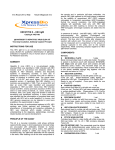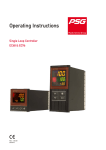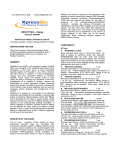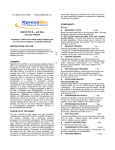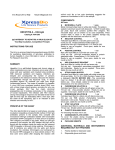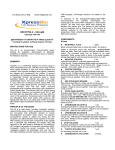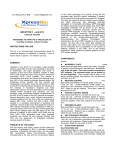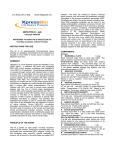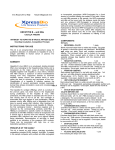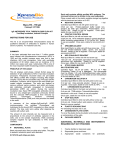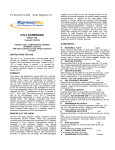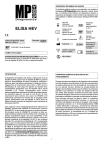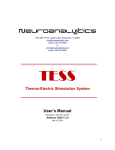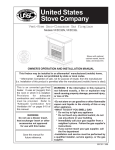Download HEPATITIS E – HEV-Ab
Transcript
For Research Use Only Not for Diagnostic Use HEPATITIS E – HEV-Ab Catalog #: WE7396 ELISA KIT FOR TOTAL ANTIBODIES TO HEPATITIS E VIRUS Two-step Incubation, Double Antigen Sandwich Principle INSTRUCTIONS FOR USE This HEV-Ab ELISA kit is an enzyme linkedimmunosorbent assay for in vitro qualitative detection of total antibodies (IgG, IgM,etc.) to hepatitis E virus in animal serum or plasma. For research use only. SUMMARY Hepatitis E virus (HEV) is a non-enveloped, single- stranded RNA virus identified in 1990. Infection with HEV induces acute or sub-clinical liver diseases similar to hepatitis A. HEV infections, endemic and frequently epidemic in developing countries, is seen also in developed countries in a sporadic form with or without a history of traveling to endemic area. The overall case-fatality is 0.5~3%, and much higher (15~25%) among pregnant women. A hypothesis that HEV infection is a zoonosis was presented in 1995. Then a swine HEV and later an avian HEV were identified and sequenced separately in 1997 and 2001. Since then, HEV infection include anti-HEV, viremia and feces excretion of HEV was seen in a wide variety of animals, i.e., swine, rodents, wild monkeys, deer, cow, goats, dogs and chicken in both the developing and developed countries. A direct testimony was reported that the consumption of uncooked dear meat contaminated with HEV led to acute hepatitis E in human, and HEV genome sequences can be detected in pork livers available in the supermarkets in Japan. With the discovery of conformational epitopes in HEV, HEV serology was further explored and understood. The phenomenon of long-lasting and protective antibodies to HEV was observed which greatly enhance the understanding to the diagnosis, epidemiology, zoonosis-related studies and vaccine development. PRINCIPLE OF THE ASSAY This HEV-Ab ELISA kit uses polystyrene microwell strips pre-coated with recombinant HEV antigens (HEV-Ag) corresponding to structural proteins ORF-2 of the native virus. Serum or plasma sample is added into the microwells. In case of presence of HEV-Ab in the sample, the pre-coated antigens will be bound to the antibody and during the first incubation step, the specific immunocomplex formed is captured on the solid phase. After washing to remove unbound sample, second recombinant HEV antigen conjugated to Horseradish Peroxidase (HRP) is added into the wells. During the second incubation step, this antigen will bind to the second variable domain of the HEV antibodies if they have been captured by HEV-antigen during the first incubation step. The unbound HRP conjugate is removed during washing and Chromogen solutions containing Tetramethylbenzidine (TMB) and urea peroxide are added into the wells. In presence of the antigen-antibody-antigen (HRP) “sandwich” complex, the colorless Chromogens are hydrolyzed by the bound HRPConjugate to a blue colored product. The amount of color intensity can be measured and is proportional to the amount of antibody captured in the wells, and to the sample respectively. Wells containing samples negative for HEV remain colorless. COMPONENTS 96 Tests MICROWELL PLATE 1 plate Blank microwell strips fixed on a white strip holder. The plate is sealed in aluminum pouch with desiccant. 8×12/12×8-well strips wells per plate. Each well contains recombinant HEV antigens. The microwell strips can be broken to be used separately. Place unused wells or strips in the plastic sealable storage bag together with the desiccant and return to 2~8ºC. NEGATIVE CONTROL 1 vial Blue-colored liquid filled in a vial with green screw cap 0.5ml per vial. Protein-stabilized buffer tested nonreactive for HEV-Ab. Preservatives: 0.1% ProClin 300. Ready to use as supplied. Once open, stable for one month at 2-8ºC. POSITIVE CONTROL 1 vial Red-colored liquid filled in a vial with red screw cap 0.5ml per vial. HEV-Ab diluted in protein-stabilized buffer Preservatives: 0.1% ProClin 300. Ready to use as supplied. Once open, stable for one month at 2-8ºC. SPECIMEN DILUENT 1 vial Green-colored liquid filled in a white vial with blue screw cap. 6ml per vial. Protein-stabilized buffer, casein, and sucrose solution. Ready to use as supplied. Once open, stable for one month at 2-8ºC. HRP-CONJUGATE REAGENT 1 vial Red-colored liquid filled in a white vial with red screw cap. 12ml per vial. Horseradish peroxidase-conjugated recombinant HEV antigens. Ready to use as supplied. Once open, stable for one month at 2-8ºC. STOCK WASH BUFFER 1 bottle Colorless liquid filled in a clear bottle with white screw cap. 50ml per bottle. pH 7.4, 20 × PBS. (Containing Tween-20 as a detergent) DILUTE BEFORE USE-The concentration must be diluted 1 to 20 with distilled/deionized water before use. Once diluted, stable for one week at room temperature, or for two weeks when stored at 2-8ºC. CHROMOGEN SOLUTION A 1 vial Colorless liquid filled in a white vial with green screw cap. 7ml per vial. Urea peroxide solution. Ready to use as supplied. Once open, stable for one month at 2-8ºC CHROMOGEN SOLUTION B 1 vial Colorless liquid filled in a black vial with black screw cap. 7ml per vial. TMB solution (Tetramethylbenzidine dissolved in citric acid). Ready to use as supplied. Once open, stable for one month at 2-8ºC. STOP SOLUTION 1 vial Colorless liquid filled in a white vial with white screw cap. 7ml per vial. Diluted sulfuric acid solution (2.0 M H2SO4). Ready to use as supplied. PLASTIC SEALABLE BAG 1 unit For enclosing the strips not in use. CARDBOARD PLATE COVER 2 sheets To cover the plates during incubation and prevent evaporation or contamination of the wells. PACKAGE INSERTS 1 copy ADDITIONAL MATERIALS AND INSTRUMENTS REQUIRED BUT NOT PROVIDED 1. Freshly distilled or deionized water. 2. Disposable gloves and timer. 3. Appropriate waste containers for potentially contaminated materials. 4. Disposable V-shaped troughs. 5. Dispensing system and/or pipette (single or multichannel), disposable pipette tips. 6. Absorbent tissue or clean towel. 7. Dry incubator or water bath, 37±0.5ºC. 8. Microshaker for dissolving and mixing conjugate with samples. 9. Microwell plate reader, single wavelength 450nm or dual wavelength 450nm and 630nm. 10. Microwell aspiration/wash system. SPECIMEN COLLECTION, TRANSPORTATION AND STORAGE 1. 2. Sample Collection: Either fresh serum or plasma samples can be used for this assay. Blood collected by venipuncture should be allowed to clot naturally and completely – the serum/plasma must be separated from the clot as early as possible as to avoid hemolysis of the RBC. Care should be taken to ensure that the serum samples are clear and not contaminated by microorganisms. Any visible particulate matters in the sample should be removed by centrifugation at 3000 RPM for at least 20 minutes at room temperature, or by filtration on 0.22u filters. Plasma samples collected into EDTA, sodium citrate or heparin may be tested, but highly lipaemic, icteric, or hemolized samples should not be used as they could give erroneous results in the assay. Do not heat inactivate samples. This can cause sample deterioration. Transportation and Storage: Store samples at 28ºC. Samples not required for assaying within 3 days should be stored frozen (-20ºC or lower).Multiple freeze-thaw cycles should be avoided. For shipment, samples should be packaged and labeled in accordance with the existing local and international regulations for transport of clinical samples and ethological agents. SPECIAL INSTRUCTIONS FOR WASHING 1. A good washing procedure is essential to obtain correct and precise analytical data. 2. It is therefore recommended to use a good quality ELISA microplate washer, maintained at the best level of washing performances. In general, no less than 5 automatic washing cycles of 350-400µl/well are sufficient to avoid false positive reactions and high background. 3. To avoid cross-contaminations of the plate with sample or HRP-conjugate, after incubation do not discard the content of the wells but allow the plate washer to aspirate it automatically. 4. Anyway, we recommend calibrating the washing system on the kit itself in order to match the declared analytical performances. Assure that the microplate washer liquid dispensing channels are not blocked or contaminated and sufficient volume of Wash buffer is dispensed each time into the wells. 5. In case of manual washing, we suggest to carry out 5 cycles, dispensing 350-400µl/well and aspirating the liquid for 5 times. If poor results (high background) are observed, increase the washing cycles or soaking time per well. 6. In any case, the liquid aspirated out the strips should be treated with a sodium hypochlorite solution at a final concentration of 2.5% for 24 hours, before liquids are wasted in an appropriate way. The concentrated Washing solution should be diluted 1 to 20 before use. For one plate, mix 50 ml of the concentrate with 950ml of water for a final volume of 1000ml diluted Wash Buffer. If less than a whole plate is used, prepare the proportional volume of solution. STORAGE AND STABILITY The components of the kit will remain stable through the expiration date indicated on the label and package when stored between 2-8 ºC, do not freeze. To assure maximum performance of this HEV-Ab ELISA kit, protect the reagents from contamination with microorganism or chemicals during storage. PRECAUTIONS AND SAFETY This kit is intended FOR RESEARCH USE ONLY The ELISA assay is a time and temperature sensitive method. To avoid incorrect result, strictly follow the test procedure steps and do not modify them. 1. Do not exchange reagents from different lots, or use reagents from other commercially available kits. The components of the kit are precisely matched as to achieve optimal performance during testing. 2. Make sure that all reagents are within the validity indicated on the kit box and are of the same lot. Never use reagents beyond the expiry date stated on reagents labels or on the kit box. 3. CAUTION - CRITICAL STEP: Allow the reagents and samples to stabilize at room temperature (18-30ºC) before use. 4. Shake reagent gently before, and return to 2-8ºC immediately after use. 5. Use only sufficient volume of sample as indicated in the procedure steps. Failure to do so may cause in low sensitivity of the assay. 6. Do not touch the bottom exterior of the wells; fingerprints or scratches may interfere with microwell reading. 7. When reading the results, ensure that the plate bottom is dry and there are no air-bubbles inside the wells. 8. Never allow the microplate wells to dry after the washing step. Immediately proceed to the next step. Avoid the formation of air-bubbles when adding the reagents. 9. Avoid assay steps long time interruptions. Assure same working conditions for all wells. 10. Calibrate the pipette frequently to assure the accuracy of samples/reagents dispensing. Always use different disposal pipette tips for each specimen and reagents as to avoid cross-contaminations. Never pipette solutions by mouth. The use of automatic pipettes is recommended. 11. Assure that the incubation temperature is 37ºC inside the incubator. 12. When adding samples, avoid touching the well’s bottom with the pipette tip. 13. When reading the results with a plate reader, it is recommended to determine the absorbance at 450nm or at 450nm with reference at 630nm. 14. All specimens from animal origin should be considered as potentially infectious. 15. Therefore, handle reagents and specimens with extreme caution as if capable of transmitting infectious diseases. Strict adherence to GLP (Good Laboratory Practice) regulations can ensure the personal safety. Never eat, drink, smoke, or apply cosmetics in the assay laboratory. 16. Bovine derived sera may have been used in this kit. Bovine serum albumin (BSA) and fetal calf sera (FCS) are derived from animals from BSE/TSE freegeographical areas. 17. The pipette tips, vials, strips and sample containers should be collected and autoclaved for 1hour at 121ºC or treated with 10% sodium hypochlorite for 30minutes to decontaminate before any further steps for disposal. 18. The Stop solution (2M H2SO4 ) is a strong acid. Corrosive. Use it with appropriate care. Wipe up spills immediately or wash with water if come into contact with the skin or eyes. ProClin 300 used as a preservative can cause sensation of the skin. 19. The enzymatic activity of the HRP-conjugate might be affected from dust, reactive chemical, and substances like sodium hypochlorite, acids, alkalis etc. Do not perform the assay in the presence of such substances. 20. Materials Safety Data Sheet (MSDS) available upon request. If using fully automated microplate processing system, during incubation, do not cover the plates with the plate cover. The tapping out of the remainders inside the plate after washing, can also be omitted. ASSAY PROCEDURE Step 1 Step 2 Step 3 Step 4 Step 5 Step 6 Step 7 Step 8 Step 9 Step 10 Reagents preparation: Allow the reagents and samples to reach room temperature (1830°C)for at least 15-30 minutes. Check the Wash buffer concentrate for the presence of salt crystals. If crystals have formed in the solution, resolubilize by warming at 37ºC until crystals dissolve. Dilute the stock Wash Buffer 1 to 20 with distilled or deionized water. Use only clean vessels to dilute the buffer. Numbering Wells: Set the strips needed in stripholder and number sufficient number of wells including three Negative control (e.g. B1, C1, D1), two Positive control (e.g. E1, F1) and one Blank (A1, neither samples nor HRP-Conjugate should be added into the Blank well). If the results will be determined by using dual wavelength plate reader, the requirement for use of Blank well could be omitted. Use only number of strips required for the test. Adding Diluent: Add 50µl Specimen Diluent into each well. Adding Sample: Add 50µl of Positive control, Negative control, and Specimen into their respective wells. Note: Use a separate disposal pipette tip for each specimen, Negative Control, Positive as to avoid crosscontamination. Incubating Sample: Cover the plate with the plate cover and incubate for 30 minutes at 37°C. It is recommended to use thermostatcontrolled water tank to assure the temperature stability and humidity during the incubation. If dry incubator is used, do not open the door frequently. Washing: At the end of the incubation, remove and discard the plate cover. Wash each well 5 times with diluted Wash buffer. Each time allow the microwells to soak for 30-60 seconds. After the final washing cycle, turn down the plate onto blotting paper or clean towel, and tap the plate to remove any remainders. Adding HRP-Conjugate: Add 100µl HRPConjugate to each well except the Blank. Incubating: Cover the plate with the plate cover and incubate the plate for 30 minutes at 37°C Washing: At the end of the incubation, remove and discard the plate cover. Wash each well 5 times with diluted Wash Buffer as in Step6. Coloring: Dispense 50 µl of Chromogen A and 50µl Chromogen B solution into each well including the Blank and mix by tapping the plate gently. Incubate the plate at 37ºC for 15 minutes avoiding light. The enzymatic reaction between the Chromogen A/B solutions produces blue color in Positive control and HEV-Ab positive sample wells. Step 11 Stopping Reaction: Using a multichannel pipette or manually add 50µl Stop Solution into each well and mix gently by tapping the plate. Intensive yellow color develops in Positive control and HEV-Ab positive sample wells. Step 12 Measuring the Absorbance: Calibrate the plate reader with the Blank well and read the absorbance at 450nm. If a dual filter instrument is used, set the reference wavelength at 630nm. Calculate the Cut-off value and evaluate the results. (Note: read the absorbance within 15 minutes after stopping the reaction) INTERPRETATION OF RESULTS AND QUALITY CONTROL Each microplate should be considered separately when calculating and interpreting results of the assay, regardless of the number of plates concurrently processed. The results are calculated by relating each sample’s optical density (OD) value to the Cut-off value (C.O.) of the plate. If the Cut-off reading is based on single filter plate reader, the results should be calculated by subtracting the Blank well OD value from the print report values of samples and controls. In case the reading is based on Dual filter plate reader, do not subtract the Blank well OD from the print report values of samples and controls. 1. Calculation of Cut-off value (C.O.) = *NC + 0.12 *NC = the mean absorbance value for three negative controls. Example: 1. Calculation of NC: Well No B1 C1 D1 Negative controls OD value 0.02 0.012 0.016 NC=0.016 2. Calculation of Cut-off (C.O.)= 0.016 + 0.12= 0.136 If one of the Negative control values does not meet the Quality control range specifications, it should be discarded and the mean value is calculated again using the remaining two values. If more than one negative control OD value does not meet the Quality control range specifications, the test is invalid and must be repeated. 2. Quality control range: The test results are valid if the Quality Control criteria are verified. It Is recommended that each laboratory must establish appropriate quality control system with quality control material similar to or identical with the patient sample being analyzed. 1. The OD value of the Blank well, which contains only Chromogens and Stop solution, is less than 0.080 at 450 nm. The OD value of the Positive control must be equal to or greater than 0.800 at 450/630nm or at 450nm after blanking. 3. The OD value of the Negative control must be less than 0.100 at 450/630nm or at 450nm after blanking. 3. Interpretations of the results: (S = the individual absorbance (OD) of each specimen) Negative Results (S/C.O. <1) : samples giving absorbance less than the Cut-off value are negative for this assay, which indicates that no antibodies to hepatitis E virus have been detected with this HEV-Ab ELISA kit. Positive Results (S/C.O. ≥1) : samples giving an absorbance greater than or equal to the Cut-off value are considered initially reactive, which indicates that antibodies to hepatitis E virus have probably been detected using this HEV-Ab ELISA kit. Retesting in duplicates of any reactive sample is recommended. Repeatedly reactive samples could be considered positive for antibodies to HEV. Borderline (S/C.O. =0.9-1.1) : Samples with absorbance to Cut-off ratio between 0.9 and 1.1 are considered borderline and retesting of these samples in duplicates is recommended to confirm the results. Repeatedly positive samples could be considered positive for antibodies to HEV. 2. VALIDITY Please do not use this kit beyond the expiry date indicated on the kit box and reagent labels. LIMITATIONS 1. Non-repeatable positive result may occur due to the general biological of the ELISA assays. This assay is designed to achieve very high performance characteristics of sensitivity and specificity and the “sandwich model” minimizes the unspecific reactions due to interference with unknown matters in sample. A negative result with anantibody detection test does not preclude the possibility of infection. 2. Common sources for mistakes: kits beyond the expiry date, bad washing procedures, contaminated reagents, incorrect assay procedure steps, insufficient aspiration during washing, failure to add samples or reagents, equipment, timing, volumes, sample nature and quality. 3. The prevalence of the marker will affect the assay’s predictive values. 4. This is a qualitative assay and the results cannot be use to measure antibodies concentrations. 5. Non-repeatable positive result may occur due to the general biological of the ELISA assays. This assay is designed to achieve very high performance characteristics of sensitivity and specificity and the “sandwich model” minimizes the unspecific reactions due to interference with unknown matters in sample. A negative result with an antibody detection test does not preclude the possibility of infection. 6. Common sources for mistakes: kits beyond the expiry date, bad washing procedures, contaminated reagents, incorrect assay procedure steps, insufficient aspiration during washing, failure to add samples or reagents, equipment, timing, volumes, sample nature and quality. 7. The prevalence of the marker will affect the assay’s predictive values. 8. This is a qualitative assay and the results cannot be use to measure antibodies concentrations. INDICATIONS OF INSTABILITY OR DETERIORATION OF THE REAGENTS 1. Values of the Positive or Negative controls ,which are out of the indicated Quality control range, are indicator of possible deterioration of the reagents and/or operator or equipment errors. In such case, the results should be considered as invalid and the samples must be retested. In case of constant erroneous results classified as due to deterioration or instability of the reagents. 2. If after mixing of the Chromogen A and B solutions into the wells, the, the color of the mixture turns blue within few minutes, do not continue carrying out the testing and replace the reagents with fresh ones. REFERENCES: 1. Reyes GR, Purdy MA, Kim JP, et al. Isolation of a cDNA from the virus responsible for enterically transmitted non-A, non-B hepatitis. Science 1990; 247: 1335–1339. 2. Clayson E, Innis B, Myint K, et al. Detection of hepatitis E virus infections among domestic swine in the Kathmandu Valley of Nepal. Am J Trop Med Hyg,1995,53:228–232. 3. Meng XJ, Purcell RH, Halbur PG, et al. A novel virus in swine is closely related to the human hepatitis E virus. Proc Natl Acad Sci USA, 1997, 94: 9860–9865. 4. Tei S, Kitajima N, Takahashi K, et al. Zoonotic transmission of hepatitis E virus from deer to human beings. Lancet 2003; 362(9381):371 5. Zheng YJ, Zhang J, Xia NS. A debate about that hepatitis E is a zoonosis. Chinese J Zoonosis (in press) 6. Wang YC, Zhang HY, Xia NS, et al. Prevalence, Isolation, and Partial Sequence Analysis of Hepatitis E Virus From Domestic Animals in China. J Med Virol 2002,67:516–521 7. Zhang JZ, Ng MH, Xia NS, et al. Conformational Antigenic Determinants Generated by Interactions Between a Bacterially Expressed Recombinant Peptide of the Hepatitis E Virus Structural Protein. J Med Virol 2001,64:125-132 8. Stanley WK, Zhang JZ, Zhuang H, et al. A bacterially expressed p a recombinant peptide of virus capsid protein. J Virol 2003(in press) 9. Zhang J, Ge SX, Huang GY, et al. Evaluation of antibody based and nucleic acid based assays for diagnosis of hepatitis E virus infection in a rhesus monkey model. J Med Virol 2003 (in press) 10. He ZQ, Ge SX, Qiu Y, et al. Establishment and primary application of double antigen sandwich ELISA for detection of hepatitis E virus antibody. Chinese J Zoonosis 2002,18(6):18-21 Express Biotech International P.O. BOX 458 Thurmont, MD 21788 USA Tel: 301-228-2444 Fax: 301-560-6570 Toll Free: 888-562-8914 www.xpressbio.com [email protected]





